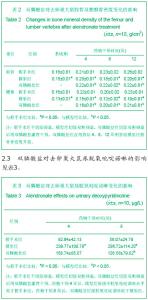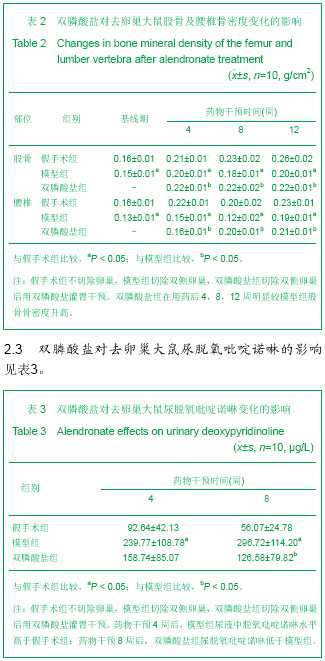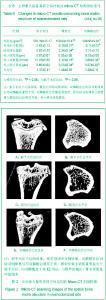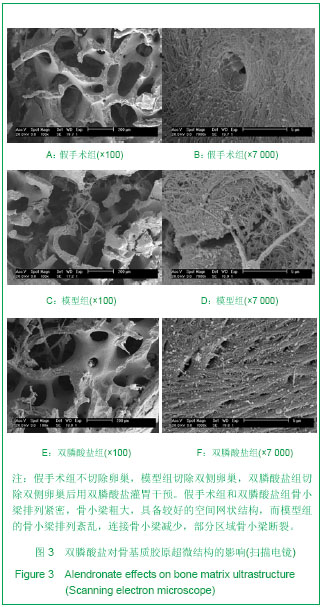Chinese Journal of Tissue Engineering Research
Alendronate improves bone matrix structure of ovariectomized rats
Wang Xiang, Guo Hai-ling, Zhao Yong-fang, Zhan Hong-sheng, Shi Yin-yu
- Shi’s Center of Orthopedics and Traumatology, Shuguang Hospital Affiliated to Shanghai University of TCM, Institute of Traumatology & Orthopedics, Shanghai Academy of TCM, Shanghai 201203, China
-
Revised:2013-10-16Online:2013-12-10Published:2013-12-10 -
Contact:Guo Hai-ling, Master, Shi’s Center of Orthopedics and Traumatology, Shuguang Hospital Affiliated to Shanghai University of TCM, Institute of Traumatology & Orthopedics, Shanghai Academy of TCM, Shanghai 201203, China ghl22007190@163.com -
About author:Wang Xiang☆, M.D., Attending physician, Shi’s Center of Orthopedics and Traumatology, Shuguang Hospital Affiliated to Shanghai University of TCM, Institute of Traumatology & Orthopedics, Shanghai Academy of TCM, Shanghai 201203, China w8x@163.com
CLC Number:
Cite this article
Wang Xiang, Guo Hai-ling, Zhao Yong-fang, Zhan Hong-sheng, Shi Yin-yu. Alendronate improves bone matrix structure of ovariectomized rats[J]. Chinese Journal of Tissue Engineering Research, doi: 10.3969/j.issn.2095-4344.2013.50.001.
share this article
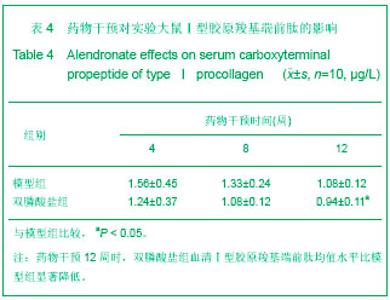
从表3可以看出大鼠去卵巢造模成功应用药物干预4周后,模型组尿液中脱氧吡啶诺啉水平高于假手术组(P < 0.01),双膦酸盐组虽然在均值上出现升高,但同假手术组相比差异无显著性意义(P > 0.05),提示药物干预4周时,已显示出明显抑制骨吸收的作用。药物干预8周后,模型组尿脱氧吡啶诺啉始终维持在较高水平(P < 0.05),提示双膦酸盐能够持续抑制骨吸收。大鼠去卵巢后药物干预8周过程中,双膦酸盐组大鼠尿脱氧吡啶诺啉水平呈现出下降趋势(P < 0.05),而模型组大鼠尿脱氧吡啶诺啉始终维持较高浓度,并有升高的趋势(P < 0.05),提示此次实验的干预药双膦酸盐显示抑制因大鼠去卵巢导致骨吸收增加的作用。 2.4 双膦酸盐对去卵巢大鼠血清Ⅰ型胶原羧基端前肽浓度的影响 从表4实验可以看出大鼠去卵巢造模成功应用药物干预4,8,12周时,双膦酸盐组血清Ⅰ型胶原羧基端前肽均值水平比模型组明显降低,应用统计方法分析显示在12周处死时间点处双膦酸盐组与模型组相比差异有显著性意义(P < 0.05),结果提示实验大鼠去卵巢后骨转换明显增加,应用药物双膦酸盐干预后,药物的作用一定程度上抑制了过高的骨转换。结果提示,这次研究的干预药物双膦酸盐显示抑制因大鼠去卵巢导致血清Ⅰ型胶原羧基端前肽增加的作用。"
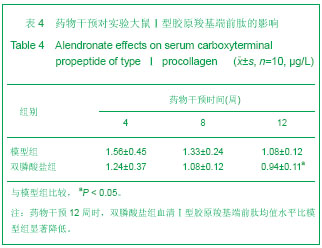
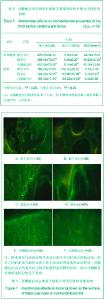
2.5 双膦酸盐对去卵巢大鼠骨生物力学的影响 由表5结果提示,去卵巢6个月后,模型组第3腰椎和股骨的生物力学性能均明显下降,在腰椎与股骨最大载荷、腰椎与股骨最大压强和腰椎与股骨模量等指标上与假手术组相比均降低(P < 0.05),而双膦酸盐组药物干预结束后第3腰椎和股骨的最大载荷和最大压强得到一定的改善(P < 0.05)。 2.6 双膦酸盐对去卵巢大鼠骨小梁表面骨转换的影响 见图1。药物干预12周后,假手术组骨小梁表面两条标记线非常接近,模型组的双标记线之间距离明显宽于假手术组,提示去卵巢后大鼠小梁骨表面骨转换明显增加,而双膦酸盐组显示两条双标记线的距离明显较模型组短,而且双膦酸盐组的两条标记线几乎重叠,提示两种药物在一定程度上抑制了因去卵巢导致的骨小梁表面骨转换的升高。"
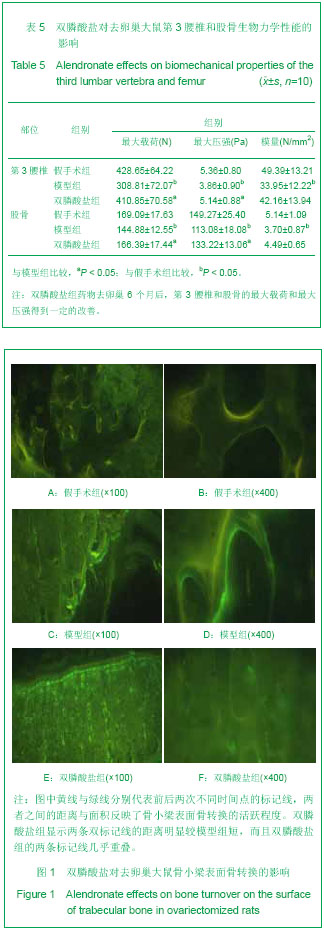
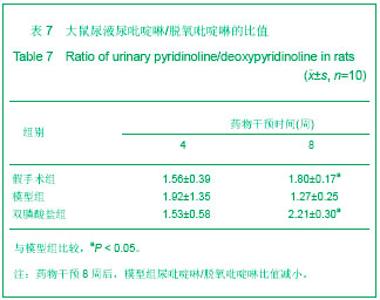
表6为Micro-CT检测结果,其中骨密度结果和结构模型指数显示模型组同假手术组比较差异有显著性意义(P < 0.01);骨组织形态计量学参数中的骨体积分数(BVF)、骨小梁数量(Tb.N)和骨小梁分离度(Tb.Sp)等指标模型组和假手术组比较差异有显著性意义(P < 0.01);但在骨小梁厚度(Tb.Th)和各向异性(Anisotropy)指标中虽然模型组在均值上表现出下降,但差异无显著性意义 (P > 0.05)。 药物干预12周后,双膦酸盐组骨骼的骨密度、骨体积分数、骨小梁数量和骨小梁分离度与模型组比较差异有显著性意义(P < 0.01),提示双膦酸盐均能改善因去卵巢造模引起的骨小梁结构的恶化。形态学观察发现,模型组骨小梁数量明显少于假手术组,而双膦酸盐干预12周后,与模型组相比,骨小梁数量明显增多,排列紧密,见图2。 2.8 双膦酸盐对骨内Ⅰ型胶原交联形式的影响 吡啶啉和脱氧吡啶啉是体内Ⅰ型胶原成熟交联的两种形式,表7显示大鼠去卵巢造模成功应用药物干预后,3组实验动物之间尿吡啶啉/脱氧吡啶啉的组分变化,应用单因素方差分析方法比较3组之间在用药4周时差异无显著性意义(P > 0.05);而应用药物干预8周后,尿液中Ⅰ型胶原代谢产物吡啶诺啉和脱氧吡啶诺啉组份发生改变,模型组尿吡啶啉/脱氧吡啶啉比值减小(P < 0.05),提示应用药物干预8周后尿中反应大鼠体内Ⅰ型胶原不同交联形式的尿吡啶啉和脱氧吡啶啉构成比发生改变。"
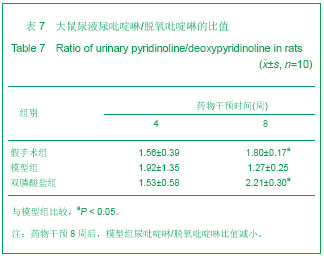
| [1] Papapoulos SE, Landman JO, Bijvoet OL, et al. The use of bisphosphonates in the teratment of osteoporosis. Bone. 1992;13(Suppl 1):S41-S49.[2] Donaldson MG, Palermo L, Ensrud KE, et al. Effect of alendronate for reducing fracture by FRAX score and femoral neck bone mineral density: the Fracture Intervention Trial. J Bone Miner Res. 2012;27(8):1804-1810.[3] Black DM, Schwartz AV, Ensrud KE, et al. Effects of continuing or stopping alendronate after 5 years of treatment: the fracture intervention trial long-term extension (FLEX): a randomized trial. JAMA. 2006;296(24):2927-2938.[4] Bone HG, Hosking D, Devogelaer JP, et al. Ten years experience with alendronate for osteoporosis in postmenopausal women. N Engl J Med. 2004;350(12): 1189-1199.[5] The Ministry of Science and Technology of the People’s Republic of China. Guidance Suggestions for the Care and Use of Laboratory Animals. 2006-09-30.[6] Tezval M, Banhardt A, Sehmisch S, et al. The effects of parathyroid hormone applied at different regimes on the trochanteric region of the femur in ovariectomized rat model of osteoporosis. J Osteoporos. 2011;2011:363617.[7] 陈孟诗,赖胜祥,李良,等.大鼠的骨生物力学指标选取及测试[J].生物医学工程学杂志,2001,18(4):547-551.[8] Goldschlager T, Abdelkader A, Kerr J, et al. Undecalcified bone preparation for histology, histomorphometry and fluorochrome analysis. J Vis Exp. 2010;8;(35).[9] Amit S. Mistry, Quynh P. Pham, Corinne Schouten, et al. In vivo bone biocompatibility and degradation of porous fumarate-based polymer/alumoxane nanocomposites for bone tissue engineering. J Biomed Mater Res A. 2010;92(2): 451-462. [10] Lazenby RA, Angus S, Cooper DM, et al. A three-dimensional microcomputed tomographic study of site-specific variation in trabecular microarchitecture in the human second metacarpal. J Anat. 2008;213(6):698-705.[11] Kopperdahl DL, Keaveny TM. Yield strain behavior of trabecular bone. J Biomech. 1998;31(7):601-608.[12] Mosekilde L, Danielsen CC. Biomechanical competence of vertebral trabecular Bone in relation to ash density and age in normal individuals. Bone.1987;8(2):79-85.[13] Siris ES, Chen YT, Abbott TA, et al. Bone mineral density thresholds for pharmacological intervention to prevent fractures. Arch Intern Med. 2004;164(10):1108-1112.[14] Wainwright SA, Marshall LM, Ensrud KE, et al. Hip fracture in women without osteoporosis. J Clin Endocrinol Metab. 2005; 90(5):2787-2793.[15] Ding M, Hvid I. Quantification of age-related changes in the structure model type and trabecular thickness of human tibial cancellous bone. Bone. 2000;26(3):291-295.[16] Van der Linden JC, Homminga J, Verhaar JA, et al. Mechanical consequences of bone loss in cancellous bone. J Bone Miner Res. 2001;16(3):457-465.[17] Ciarelli TE, Fyhrie DP, Schaffler MB, et al. Variations in three-dimensional cancellous bone architecture of the proximal femur in female hip fractures and in controls. J Bone Miner Res. 2000;15(1):32-40. [18] Marotti G, Muglia MA, Palumbo C. Structure and function of lamellar bone. Clin Rheumatol. 1994;13 Suppl 1:63-68.[19] Borah B, Dufresne TE, Chmielewski PA, et al. Risedronate preserves bone architecture in postmenopausal women with osteoporosis as measured by three-dimensional microcomputed tomography. Bone. 2004;34(4):736-746.[20] Kim M, Na W, Sohn C. Vitamin K1 (phylloquinone) and K2 (menaquinone-4) supplementation improves bone formation in a high-fat diet-induced obese mice. J Clin Biochem Nutr. 2013;53(2):108-113.[21] Dempster DW, Cosman F, Kurland ES, et al. Effects of daily treatment with parathyroid hormone on bone microarchitecture and turnover in patients with osteoporosis: a paired biopsy study. J Bone Miner Res. 2001;16(10): 1846-1853.[22] Jiang Y, Zhao JJ, Mitlak BH, et al. Recombinant human parathyroid hormone (1-34) [teriparatide] improves both cortical and cancellous bone structure. J Bone Miner Res. 2003;18(11):1932-1941.[23] Banse X, Sims TJ, Bailey AJ X. Mechanical properties of adult vertebral cancellous bone: correlation with collagen intermolecular cross-links. J Bone Miner Res. 2002;17(9): 1621-1628.[24] Banse X, Devogelaer JP, Lafosse A, et al. Cross-link profile of bone collagen correlates with structural organization of trabeculae. Bone. 2002;31(1):70-76. |
| [1] | Kong Desheng, He Jingjing, Feng Baofeng, Guo Ruiyun, Asiamah Ernest Amponsah, Lü Fei, Zhang Shuhan, Zhang Xiaolin, Ma Jun, Cui Huixian. Efficacy of mesenchymal stem cells in the spinal cord injury of large animal models: a meta-analysis [J]. Chinese Journal of Tissue Engineering Research, 2020, 24(在线): 3-. |
| [2] | Li Xiaoqun, Xu Kaihang, Ji Fang. Corylin inhibits osteoclastogenesis and attenuates postmenopausal osteoporosis in mice [J]. Chinese Journal of Tissue Engineering Research, 2020, 24(在线): 4-. |
| [3] | Zhong Yuanming, Luo Man, Tang Fubo, Tang Cheng. Relationship between a linear black signal area of STIR image in MRI of osteoporotic thoracolumbar fracture and the size of external force [J]. Chinese Journal of Tissue Engineering Research, 2020, 24(9): 1400-1404. |
| [4] | Liu Qun, Sun Dongdong, Gao Lilan, He Zhijiang, Sun Minglin. Risk factors for fractures secondary to percutaneous kyphoplasty: a meta-analysis [J]. Chinese Journal of Tissue Engineering Research, 2020, 24(6): 976-984. |
| [5] | Li Shuyuan, Zhou Qishi, Li Yue, Zhou Hongliang, Yang Jiabao, Hu Cheng. Comparisons of induced membrane vascularization and osteogenic factor expression in different tissue sites [J]. Chinese Journal of Tissue Engineering Research, 2020, 24(5): 667-672. |
| [6] | Cao Guolong, Tian Faming, Liu Jiayin. Lovastatin combined with insulin effects on fracture healing in rat models of bilateral ovariectomized type 2 diabetic mellitus [J]. Chinese Journal of Tissue Engineering Research, 2020, 24(5): 673-681. |
| [7] | Yu Peiyuan, Zhang Zhida, Liang Lichang, Yang Zhidong, Huang Jinjing, Peng Jiancheng, Liang Ziyang, He Jiahui, Zhao Wenhua, Yu Fuyong, Chen Guifeng, Liang De, Jiang Xiaobing . Difference in the effect of metformin on bone strength of lumbar vertebrae and hind limbs in diabetic rats [J]. Chinese Journal of Tissue Engineering Research, 2020, 24(5): 657-661. |
| [8] | Zhang Shiyong, Wang Chengwei, Wang Xue, Yan Xiangli, Wang Jie. Application of digital subtraction angiography in dog hindlimb arteriography [J]. Chinese Journal of Tissue Engineering Research, 2020, 24(5): 704-708. |
| [9] | Ge Juncheng, Ma Jinhui, Wang Bailiang, Yue Debo, Sun Wei, Wang Weiguo, Guo Wanshou, Li Zirong. Application of bisphosphonates in avascular necrosis of the femoral head [J]. Chinese Journal of Tissue Engineering Research, 2020, 24(5): 753-759. |
| [10] | Luo Peijie, Yuan Kai, Li Daxing, Zhang Shuncong, Guo Huizhi, Tang Yongchao, Zhou Tengpeng, Guo Danqing, Li Yongxian, Mo Guoye. Comparison of the short-segment and long-segment cement-augmented pedicle screw fixation for osteoporotic thoracolumbar fracture: a finite element study [J]. Chinese Journal of Tissue Engineering Research, 2020, 24(3): 342-347. |
| [11] | Liu Ruizhen, Wang Wangren, Hao Chen, Liang Dongmu, Guan Haishan. Effect of bone cement distribution on adjacent vertebral body fracture after unilateral percutaneous vertebroplasty for single segment osteoporotic vertebral compression fracture [J]. Chinese Journal of Tissue Engineering Research, 2020, 24(28): 4498-4504. |
| [12] | Xie Hui, Chen Haopeng, Wang Benjie, Fu Weimin, Zhao Dewei. Effect of different distribution types of bone cement after percutaneous kyphoplasty on osteoporotic vertebral compression fractures at different sites [J]. Chinese Journal of Tissue Engineering Research, 2020, 24(28): 4505-4510. |
| [13] | Yao Shunhan, Wei Huacheng, Qin Jiagang, Liao Liang. Mogroside V stimulates osteoblast proliferation and differentiation by promoting LncRNA TUG1 expression [J]. Chinese Journal of Tissue Engineering Research, 2020, 24(26): 4129-4134. |
| [14] |
Li Shaoshuo, Gu Yidan, Shao Yang, Yin Heng, Wang Jianwei.
Visualization analysis of CiteSpace knowledge maps regarding prevention and treatment of postmenopausal osteoporosis with traditional Chinese medicine [J]. Chinese Journal of Tissue Engineering Research, 2020, 24(26): 4224-4230. |
| [15] |
Dong Xiling, Zhang Xiaoming, Liu Tongbin.
Recombinant human parathyroid hormone (1-34): pro-osteogenic action and application in oral field [J]. Chinese Journal of Tissue Engineering Research, 2020, 24(26): 4231-4236. |
| Viewed | ||||||
|
Full text |
|
|||||
|
Abstract |
|
|||||
